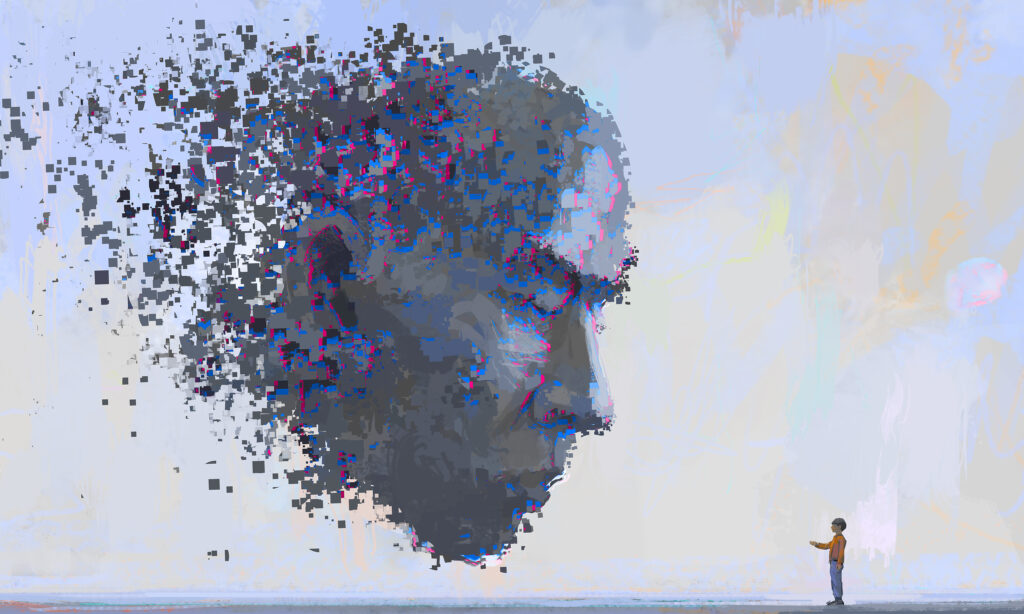Generative AI is a branch of artificial intelligence (AI) that creates models and systems capable of generating new content, such as images, text, music, and more. These systems learn patterns and structures from existing data and generate new instances resembling the training data. Generative AI is often based on deep learning techniques, explicitly using generative models such as generative adversarial networks (GANs) and variational autoencoders (VAEs).
Generative AI Applications
Generative AI has recently gained significant attention due to its ability to produce realistic and creative outputs. Some notable applications of generative AI include:
Image Generation:
Generative models can generate new images that resemble existing ones. This has applications in various domains, such as creating realistic human faces, developing new artwork, and enhancing image processing tasks.
Image Generated by Generative AI
Text Generation:
Natural language processing (NLP) models can generate coherent and contextually relevant text. These models have been used for language translation, text completion, and story generation.
Examples of Text to Text Generative AI are ChatGPT, Bard, etc.
Music Composition:
AI generative models can create original musical compositions. They learn from existing musical data to generate new melodies, harmonies, and even entire songs.
Examples of AI music generators are Amper Music, SoundDraw, etc.
Video Synthesis:
Generative models can generate new video sequences by learning from existing video data. This has applications in video editing, special effects generation, and virtual reality.
Examples of AI video generators are Descript, Runway, etc.
Data Augmentation:
Generative AI can be used to augment training datasets by generating synthetic data. This helps in improving the performance and robustness of machine learning models.
Examples of data augmentation are medium.com, github.com, etc.
You may also like to read about: Redefining Employment: The Rise of AI and Job Markets.
Examples of Generative AI
StyleGAN:
StyleGAN is a popular generative model that can create high-quality synthetic images. It has been used to generate realistic human faces, create new artwork, and even cause entirely fictional creatures.
ChatGPT:
ChatGPT is a conversational AI model that can generate text-based responses casually. It has been trained on vast text data and can generate contextually relevant and coherent answers to user queries.
Image Source
DeepDream:
DeepDream is a generative AI technique developed by Google that modifies images to enhance patterns and create visually striking, dream-like effects. It uses deep neural networks to analyze and manipulate images.
MuseNet:
MuseNet is a generative model that composes original music in various styles and genres. It has been trained on a vast repertoire of musical data and can generate complex compositions with multiple instruments and melodies.
DALL-E:
DALL-E is a generative model developed by OpenAI that can create unique and novel images based on textual descriptions. It can generate images of imaginary objects or scenes that do not exist in the real world.
Generative AI offers several benefits and opportunities across educational domains.
The Significance of Generative AI in the Realm of Education
Generative AI holds significant importance for education as it has the potential to revolutionize various aspects of the learning experience. Here are several ways in which generative AI can contribute to education:
Content Creation:
Generative AI models can create educational content like quizzes, exercises, and interactive simulations. These models can generate tailored educational materials based on individual student needs, enabling personalized and adaptive learning experiences.
Language Learning:
Generative AI can assist in language learning by providing interactive conversational agents. These agents can simulate real-life conversations, allowing students to practice speaking and improve their language skills in a supportive environment.
Virtual Teachers and Tutors:
Generative AI can be used to develop virtual teachers or tutors that offer personalized instruction and guidance. These virtual educators can adapt to individual student learning styles, answer questions, and provide explanations, enhancing the learning process.
Intelligent Feedback and Assessment:
Generative AI can analyze student work and provide intelligent feedback on assignments and assessments. It can identify strengths and weaknesses, offer suggestions for improvement, and provide tailored recommendations to help students progress in their learning journey.
Creative Expression and Collaboration:
Generative AI tools can enable students to explore their creativity by generating artwork, music, or storytelling elements. These tools can foster collaboration among students, encouraging them to work together in creating and sharing their ideas.
Concerns Surrounding the Use of Generative AI in Education
- Privacy
First and foremost, there is the issue of data privacy and security. Generative AI systems often require large amounts of data to train and generate content. This raises concerns about the privacy and protection of sensitive student information and the potential for data breaches or unauthorized access.
Generative AI systems rely on substantial data quantities for training and content generation.
- Bias
Another concern is the potential for bias in generative AI systems. These systems learn from existing data, which may contain biases and stereotypes. This can perpetuate and amplify existing educational inequalities and prejudices if not adequately addressed. Ensuring that generative AI models are trained on diverse and inclusive datasets and regularly monitored and evaluated for fairness and bias is crucial.
- Reliability
Additionally, there is the risk of over-reliance on generative AI in the educational process. While these systems can automate specific tasks and provide personalized learning experiences, it is essential to strike a balance and not entirely replace human interaction and guidance. Students still benefit from real-time feedback, social interaction, and critical thinking skills that can be nurtured through human interaction.
Students have developed a firm reliance on Generative AI.
- Ethics
There are concerns regarding the authenticity and originality of generated content. Plagiarism and academic integrity become significant concerns when students have access to AI-generated essays, papers, or assignments. Establishing guidelines and educational policies that promote the ethical use of generative AI tools and emphasize the importance of original thinking and creativity is crucial.
While generative AI has the potential to enhance education in numerous ways, it is essential to address concerns related to data privacy, bias, over-reliance, and ethical implications. By addressing these concerns, we can harness the benefits of generative AI while ensuring a safe, inclusive, and effective educational environment.













